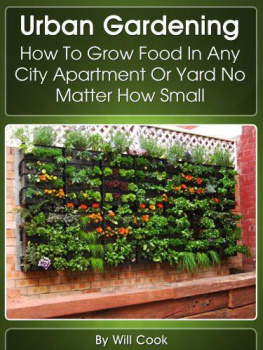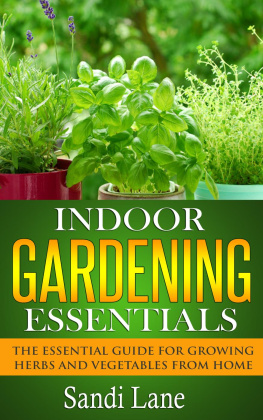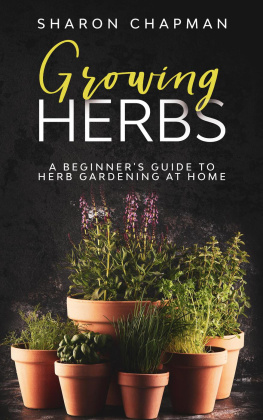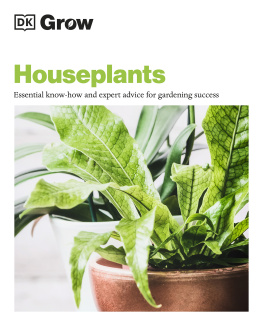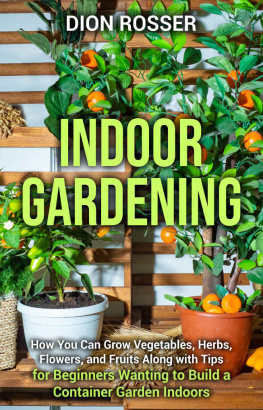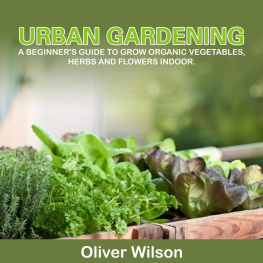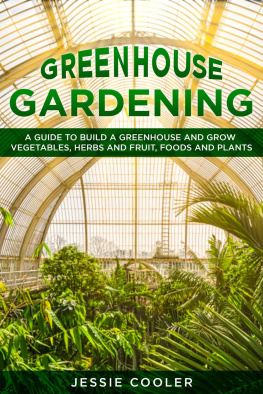The Windowsill Gardening Guide
The Fun and Simple Way to Grow Food at Home in Any Climate
Will Cook
Copyright 2013 by Will Cook. All Rights Reserved.
Published by TCK Publishing
Published by TCK Publishing
www.TCKPublishing.com
Get discounts and special deals on books at
www.tckpublishing.com/bookdeals
Want to connect with like-minded aquaponic gardeners from all over the world? Come join us on Facebook to share your indoor gardening questions, ideas, pictures, and be a part of the global gardening community!
Join us at on.fb.me/HmllNU
Table of Contents
Why You Should Read This Book
Why Have a Windowsill Garden?
Waste is everywhere, and budgets are tight. The food that you throw away is a resource that you didnt know you have, and it contributes in no small part to the humongous landfills that are a major environmental problem. Aside from environmental concerns, there is money to be made in terms of savings from the organic waste you unhesitatingly throw into the garbage bin or compacter; they can easily be used to grow food you eat every day! How you might ask? Windowsill gardening!
The carrot tops or old potatoes you throw into the trash bin contribute to the 40% of perfectly good organic material that just goes to waste in the United States. In fact, about 50% of the food produced in the United States goes into landfills, a cash equivalent of $165 million a year. Makes you think, doesnt it?
The average American household throws out about $30 of food a month or about 20 pounds of foodstuff. Thats not including the cost of buying the stuff you do use when you could actually grow it on your windowsill.
If every household saves some of the stuff you throw away and plants them or uses them as compost, say 10%, thats $16.5 million you dont throw out and some savings from stuff you can grow yourself instead of buying. Even if you cant eat it, the plants you grow from scraps can make pretty good houseplants and table centers, plus it makes a good project for yourself and with your kids, if you have any.
Im not good at growing stuff

Windowsill gardens dont really take a lot of skill; a lot of the best windowsill plants grow easily and take very little care once they take root. Having a garden indoors which you can look at and give your kitchen a homey feel is a benefit in itself but many of the plants you can grow can actually be used in the kitchen or as decorations for the rest of the house. These include spring onions, carrot tops, pineapple plants, garlic, and so on. You can also grow herbs that look very pretty, and you can snip off anytime you need a sprig or two.
Would it really make a difference?
From a purely practical point of view, perhaps your cash savings may not be a lot, and it does take some effort to make a windowsill garden, but from a psychological and environmental perspective, growing a windowsill garden not only counts towards the satisfaction of knowing you have something beneficial growing in your home but also that you are helping the environment by increasing the greenery in your own little pocket of the world, and we have already talked about the landfill situation.
So the answer is yes, it does make a difference when you grow your windowsill garden. It may not be a lot in global terms but if everyone did it, who knows what the eventual impact will be? It is time we did something about the food were wasting, the money were taking out of our pockets, and our contribution to environmental problems. We need to do something to change all that, even if only in a little way.
There are several ways that we can do this, and some are more ingenious than others. Obviously, if we buy only what we can consume, that would stop the food wastage. But we still have trash to throw out, no matter how efficient we are in our food preparation.
And then there are the things that we buy, such as garden herbs and houseplants. Keeping those to a minimum would greatly help our budget and still keep our home pretty and our dishes tasty through windowsill gardening.
This book is all about starting a windowsill garden as painlessly and quickly as possible. All you need is a windowsill, some pots and soil, acceptable food scraps, store-bought seeds, a little ingenuity, plus this book, and you are taking the first steps towards a healthier, prettier, more economical home.
Chapter One: Start with the Basics
With space a commodity in the city, you want to make every inch count. That ledge inside or outside your kitchen windowsill is 18 inches by 6 inches of wasted space that would be ideal for bringing in some green into an otherwise barren landscape. Furthermore, windowsill gardens obviously work anywhere so even if you live in a place where you have some yard space, it is pretty and functional at the same time.
Before you get started, there are some things you need to know if you are a first time gardener.
Grow Your Seedlings
Growing your seedlings is the first thing you need to do. You can use one or several methods in making your own personal stash of seedlings for your windowsill garden. Even if you start with store-bought seeds (which you will with herbs; more on that later), you will need to sprout them properly.
You will find below the 5 ways that most seedlings are grown and the difference is in the medium used. The method you select will depend on the kind of vegetation you plan to propagate. In most cases, there are two or more equally good ways to grow seedlings but if you choose the wrong one, you could end up with a lot of dead plants.
Water
The most common medium used by amateur gardeners is water. At one point in your life, you have probably done science experiments with a potato with toothpicks partially submerged over a jar of water. This medium works especially well for tubers like potatoes or plants that have a good supply of nutrition available for sprouting roots. Other plants that do well in this sprouting medium are avocados, beets, root plants, and those with pits. You basically submerge part of the rooting segment of the plant in water and wait for roots and sprouts to appear. A rule of thumb: no matter what plant youre sprouting when it gets to be 4 inches long, you can transfer it to a more permanent medium, usually soil in a pot.
Peat moss
Some plants dont do too well if there is too much water. You can use sphagnum peat moss or regular peat moss in a re-sealable plastic bag instead. Peat moss is readily available in most garden supply stores but choose what you buy carefully. For sphagnum, you need a bag that is completely dry, the moss is a light brown color, and clump-free. You need to first hydrate the dry moss by submerging it in water and then allowing the excess water to run out until the moss is just slightly damp. With seeds, you need finely ground milled sphagnum peat moss for your starting medium. Check the plastic bag daily to check for signs of rot or mold. If there seems to be too much condensation in the bag, unseal it and leave it open for a day to let out the excess moisture.
Sphagnum or regular peat moss will grow seedlings with roots that are rather delicate and will have to be hardened before transferring it to soil or it will die. You will need to acclimatize it to a less accommodating but ultimately richer medium and the presence of sun, wind, and rain. Simply place the bag with seedlings on the sill for 3 hours initially, slowly lengthening the exposure until the roots look thicker and less delicate. You can then transfer the seedlings to soil.
Next page

